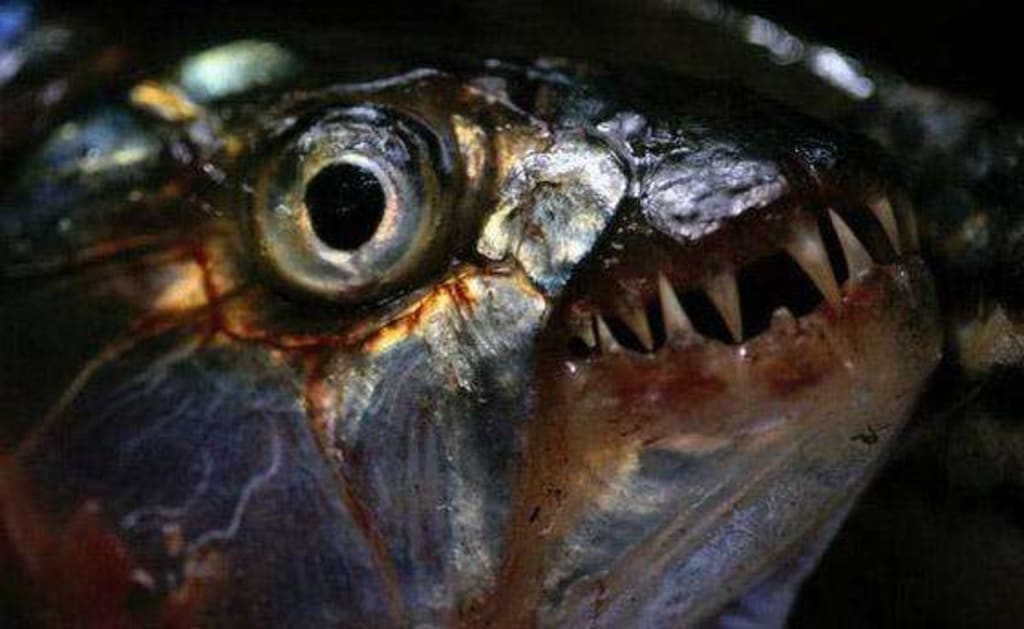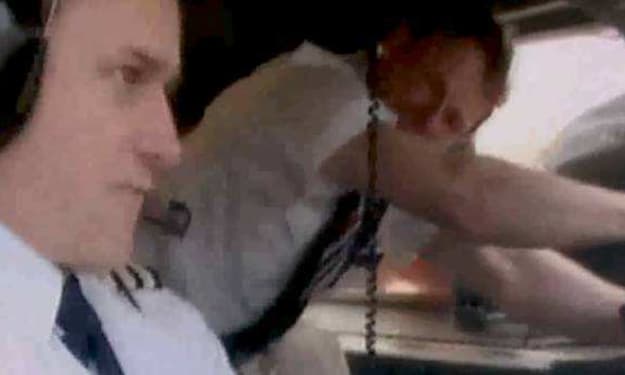Kill blood-sucking fish
Henderson, 33, has been engaged in biological expeditions and research in the wild for many years.

Mysterious little fish
Henderson, 33, has been engaged in biological expeditions and research in the wild for many years. In February 2005, Henderson's four papers on freshwater fish were commended by the Royal Society and published in an authoritative journal in the United States, causing great repercussions. The hard work finally paid off, and Henderson decided to take a good rest. In early March, Henderson and his wife Janet went on vacation to the subtropical forest of Esponte in southern Bolivia, stopping by to visit his old friend Horn. Horn, also a biologist from London, England, studies amphibians and spends five years in the subtropical forests of Esponte.
There is a small resort near the scientific research station where Horn works. In March, it is the rainy season. Due to the recent warning from the meteorological department that there may be heavy rains in the subtropical forest of Esponte, and there is a danger of flash floods on the hills near the resort, the tourists of the resort have been evacuated. But Henderson did not retreat. Such dangers were commonplace for him who often traveled in the wild. He had no fear at all, but took his wife Janet to live in the scientific research station.
The weather didn't seem to be as bad as the weather department had warned, and after a few consecutive rains, the sky cleared up. Janet, who rarely sees the wild, looked excited. This afternoon, she jumped in her swimsuit into a small lake surrounded by mountains on three sides and about two miles around the research station for a swim, while Henderson sat jutting into the lake. On the pier made of trees, watching his wife enjoy the comfort and fun of nature.
More than half an hour later, just as Janet was about to go ashore, she suddenly screamed. It turned out that the soles of her feet stepped on a tree stump hidden in the shallow water of the lake, and blood flowed out.
Henderson hurriedly jumped into the lake and dragged Janet ashore. As she swam back to shore, Janet felt something keep touching her injured foot, and every time she touched it, she felt a piercing pain.
After Henderson pulled his wife ashore, he found a hole in the sole of her foot poked by a tree stump. What made his heart palpitate even more was that he actually pulled down a small fish that had already got into half of his head from the bloody wound. Out of occupational sensitivity, Henderson carefully inspected the fish. It was very small, only about 2 centimeters long, and the markings on its body were very unique. In his impression, he had never seen a similar fish. Henderson was a little excited, he thought, is this a new species of fish? If so, it means a new discovery in biology.
Just as Henderson was studying the fish, Horn and two of his colleagues, who had been out on an expedition, returned. Seeing the wound on the soles of Janet's feet, Horn said apologetically to Henderson and Janet that he forgot to remind them that there seemed to be a problem with the water quality of the lake, and it was best not to go swimming. Horn said he has seen a dramatic decline in the species of amphibians and fish in the lake in the last six months. Because no ferocious aquatic animals were found in the lake through dragnet fishing, Horn suspected that the water quality had been polluted for some unknown reason. He was preparing to invite relevant departments to review the water quality of the lake and the surrounding ecological environment in the near future. Make a detailed test.
After listening to Horn's account, Henderson picked up the small fish that had just been pulled from the wound on the sole of Janet's foot and asked him if he had seen it before. Horn looked at the small fish and said that the fish might have flowed into the lake half a year ago. A few years ago, an environmental group near the subtropical forest of Esponte cooperated with the police to intercept a shipment of smuggled fish. The environmental group sent the fish to Horn's research station, hoping they could identify what species it was. Horn found that the fish did not appear to be interested in any food and died in large numbers in just a few days. Just as he was preparing for further research, a sudden flash flood washed down the research station and washed all the fish in the breeding pond into the lake. At that time, this seemingly ordinary accident did not attract Horn's attention. At that time, the fish was still very small and the individual was not very clear, so Horn felt that the fish Henderson was holding in his hand was a bit like those fish, but he was not absolutely sure.
Henderson immediately asked Horn to find a fishing net, and then the two rowed a small boat to the center of the lake. Henderson cast a few nets in the middle of the lake, and there were some strange little fish on the net. After landing, Henderson put the fish in a large glass jar with some other fish and amphibians in it. After more than ten minutes, after the small fish adapted to the new environment, Henderson and Horn were stunned: these small fish were attached to other fish and amphibians one after another, and bit their gills, tear their tissue, sucking the blood inside. Soon, the carcasses of blood-drained fish and amphibians were floating in the glass jars.
Disaster is imminent
When Janet witnessed this tragic scene next to her, she thought of the fish that got into her wound just now, and she couldn't help but cry out with lingering fear: "Oh, God, these terrifying'vampires'!"
Horn also said that when members of the environmental group sent the fry, they had said they were smuggled from the Amazon River Basin. Henderson had inspected the hinterland of the Amazon and was familiar with the situation there. Hearing Horn say this, he suddenly remembered the legendary "vampire" at the bottom of the river among the indigenous people of the Amazon. It is said that there is a kind of fish that specializes in sucking fish and livestock. If people are injured in the water and their blood flows out, they will also be attacked by them, but Henderson has never seen this kind of fish with his own eyes, and did not expect to see it in Bolivia today.
In the long-term process of species evolution, the animals inhabiting the Amazon River have fully adapted to the complex local environment and know how to survive in the cruel competition. Therefore, even if there are blood-sucking fish, it will not pose a big threat to the local ecosystem. Threat. However, in Bolivia, if this blood-sucking fish is allowed to flourish, it will bring huge ecological disasters. One of the most direct and significant consequences is: the number of fish and amphibians that lack defense against this blood-sucking fish will be drastically reduced. It will even cause a large number of species to go extinct!
Henderson looked at the lake, which was surrounded by mountains on three sides, and sighed with lingering fear: "If they were not trapped in this lake, but multiplied in other rivers in Bolivia, the consequences would be unimaginable!"
But how to eliminate the blood-sucking fish in the lake? This became a difficult problem for Henderson and Horn. Fishing with nets is neither scientific nor thorough; draining the lake is too much work! Henderson, Horn and two other scientists in the research station discussed for more than an hour, analyzed the pros and cons of various methods, and finally decided to use poisoning to kill the blood-sucking fish. Only in this way is the fastest and most thorough!
This unnamed lake is surrounded by mountains on three sides, and only one side is relatively low-lying and close to a stream. In the dry season, the lake is impossible to overflow, but in the rainy season, the lake often overflows the low-lying shore, flows to the creek, and then rushes down the stream into the Mamore River, which is more than 30 miles away. Once these vampire fish flow into the big river, it becomes almost impossible to control them in the future. Now what Henderson and Horn have to do is to take effective measures to prevent these vampire fish from spreading to the river before the rainy season has just arrived and the lake has not swollen.
However, poisoning a lake to kill all the creatures in it is not a trivial matter. It is not enough to rely on the oral suggestions of several scientists. It must be repeatedly studied and demonstrated by relevant departments. That night, Henderson and Horn drafted a proposal, which was to be sent to the town government more than 100 miles away the next day, and they would then hand it over to the relevant departments to implement the poisoning plan after obtaining approval.
God seemed to be against them on purpose, and late that night, just as Henderson and Horn were still weighing the words of the proposal, a heavy rain suddenly came. Several huts at the research station swayed in the storm, and seeing the pouring rain, several scientists at the research station were worried that the lake would overflow the shore, causing blood-sucking fish to rush along the creek into the river, bringing irreparable ecological disaster.
Horn went to make a phone call, trying to report the emergency to the relevant authorities in Bolivia, hoping that they could send a helicopter to urgently drop poison on the lake. But before the phone was connected, a dazzling arc of lightning swept across the night sky, followed by a deafening thunderbolt. The phone was instantly damaged. Horn was numb and staggered back several steps. Almost knocked down. At the same time, sparks splashed, and the only radio transmitter at the research station was also struck by lightning.
Witnessing this situation, Henderson sighed and shook his head. If the torrential rain cannot stop immediately, if the current momentum continues, it will take a few hours for the soaring lake water to overflow the lake shore. Maybe before the blood-sucking fish can be poisoned, the poisonous lake water will wash into the downstream rivers, which will also bring huge ecological disasters and serious environmental pollution.
Emergency interception
The wind was howling outside, the rain was pouring, and a thunder sounded, as if the ground was shaking. A sudden flash of inspiration flashed in Henderson's mind, and he said eagerly to Horn: "Quick, hurry up and drive to the town government and ask them to quickly dispatch some blasters and explosives. We can explode and create a few on the slopes on both sides of the creek. Mudslides, use collapsed rocks and clods to block the creek and prevent the overflowing lake from rushing into the river." After making a plan, Horn immediately jumped into the off-road vehicle and drove to the town government more than 100 miles away. Henderson secretly prayed in his heart that the lake would not overflow the embankment until the explosives were transported.
The lake continued to rise, and Henderson knew that in this bad weather, the already rough mountain roads must have become very muddy. If Horn's car got stuck in the mud and couldn't extricate itself or the car broke down, it would be a big trouble. So you can't bet all on explosives, you have to take some emergency measures. Henderson left his wife, Janet, to monitor the rise of the lake, and he led two other scientists at the research station who study subtropical plants to the creek in the rain, cutting a fishing net open and only a few feet away from the lake. The wide stream was divided into sections, and then some trees were felled and piled in the creek, and then rocks were brought in to suppress it in order to minimize the number of fish that slipped through the net.
After doing this, Henderson felt that it was not safe. He and the two botanists took a fishing net left over from the research station and rowed a small boat into the lake. They killed some big fish with knives and discarded them into the lake again. The boat was quickly stained red with the blood of the fish. Henderson's purpose in doing this was to lure the blood-sucking fish over to facilitate fishing.
Sure enough, the strong smell of blood attracted many blood-sucking fish, and they surrounded the lake, greedily sucking blood, and the scene made people shudder. Henderson and others took the opportunity to catch them.
Whenever the cabin was full of vampire fish, they rowed the boat to the shore and unloaded all the fish on the shore, where Janet had built a line of defense with trees and rocks to prevent the vampire fish from jumping back into the lake. But because of the heavy rain, some vampire fish did not die immediately after being thrown ashore, but swam back into the lake through the gaps in the water between the trees and rocks. Janet had to run up and down, trampling and stoning as many vampire fish as possible that crossed the line.
The boat at the research station was in disrepair, swaying in the wind and rain, and could capsize at any time. As Henderson stood on the bow casting his net, the boat jolted and threw him into the lake. There were many vampire fish tumbling where he fell, and he was covered in fish blood. He became the target of the vampire fish's attack. His skin was bitten open and blood flowed out. When this Amazon vampire fish sucks blood, it releases an anticoagulant chemical in its mouth, which prevents the blood from clotting and losing its freshness, so Henderson's wound has been bleeding. The constant flow of blood stimulated the blood-sucking fish, and he was quickly bitten all over. By the time the two botanists pulled him into the boat, Henderson, who had lost too much blood, was in a coma. But the icy rain woke Henderson up after a while. In order to hunt more blood-sucking fish, he ignored the pain and stood on the bow of the boat and continued to cast the net.
Three hours later, Horn, who had driven for help, had not returned, and the swelling lake was less than a foot from the embankment. Henderson was so anxious, but he couldn't get in touch with Horn, so he and the two botanists desperately risked the boat capsizing and being attacked by vampire fish to continue hunting "vampires". The shore was already full of the vampire fish they had caught. Due to the sheer number of fish, the defenses built up by trees and rocks could not accommodate the terrifying guys well, they jumped in the rain and many returned to the lake.
The lake continued to rise relentlessly, and just as Henderson was about to despair, he suddenly heard Janet yelling excitedly at them from the shore: "Horn is back!" Henderson saw dimly through the rain. An off-road jeep drove to the research station, followed by three large trucks.
As soon as the truck stopped, the rescuers quickly jumped down. The mayor, Gamison, personally led a few blasters to the creek. After surveying the terrain, the blasters placed explosives on several narrow passes where the creek flowed. "With a few loud noises, the mudslides on several hillsides next to the creek rolled down with trees and rocks, dividing the creek's flow to the big river 30 miles away in three sections. At almost the same time, the water in the lake overflowed, but it was blocked by the obstacles formed by the mudslides before it flowed out...
About the Creator
Iverson
Hi, I'm from Spain and love writing.
Enjoyed the story? Support the Creator.
Subscribe for free to receive all their stories in your feed. You could also pledge your support or give them a one-off tip, letting them know you appreciate their work.






Comments
There are no comments for this story
Be the first to respond and start the conversation.